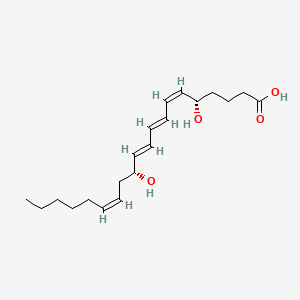| MeSH term | MeSH ID | Detail |
|---|---|---|
| Hemolysis | D006461 | 131 associated lipids |
| Airway Obstruction | D000402 | 13 associated lipids |
| Uremia | D014511 | 33 associated lipids |
| Colitis, Ulcerative | D003093 | 24 associated lipids |
| Stomach Ulcer | D013276 | 75 associated lipids |
| Kidney Failure, Chronic | D007676 | 51 associated lipids |
| Hypoxia | D000860 | 23 associated lipids |
| Adenocarcinoma | D000230 | 166 associated lipids |
| Enterocolitis | D004760 | 3 associated lipids |
| Breast Neoplasms | D001943 | 24 associated lipids |
Leukotriene b4
Leukotriene b4 is a lipid of Fatty Acyls (FA) class. The involved functions are known as Chemotaxis, release of sequestered calcium ion into cytoplasm and Polymerization. Leukotriene b4 often locates in Protoplasm. The associated genes with Leukotriene b4 are phallacidin.
Cross Reference
Introduction
To understand associated biological information of Leukotriene b4, we collected biological information of abnormalities, associated pathways, cellular/molecular locations, biological functions, related genes/proteins, lipids and common seen animal/experimental models with organized paragraphs from literatures.
What diseases are associated with Leukotriene b4?
There are no associated biomedical information in the current reference collection.
Possible diseases from mapped MeSH terms on references
We collected disease MeSH terms mapped to the references associated with Leukotriene b4
PubChem Associated disorders and diseases
What pathways are associated with Leukotriene b4
There are no associated biomedical information in the current reference collection.
PubChem Biomolecular Interactions and Pathways
Link to PubChem Biomolecular Interactions and PathwaysWhat cellular locations are associated with Leukotriene b4?
Visualization in cellular structure
Associated locations are in red color. Not associated locations are in black.
Related references are published most in these journals:
| Location | Cross reference | Weighted score | Related literatures |
|---|
What functions are associated with Leukotriene b4?
Related references are published most in these journals:
| Function | Cross reference | Weighted score | Related literatures |
|---|
What lipids are associated with Leukotriene b4?
There are no associated biomedical information in the current reference collection.
What genes are associated with Leukotriene b4?
Related references are published most in these journals:
| Gene | Cross reference | Weighted score | Related literatures |
|---|
What common seen animal models are associated with Leukotriene b4?
There are no associated biomedical information in the current reference collection.
NCBI Entrez Crosslinks
All references with Leukotriene b4
Download all related citations| Authors | Title | Published | Journal | PubMed Link |
|---|---|---|---|---|
| Akasaki T et al. | Phosphoinositide 3-kinase-dependent and -independent activation of the small GTPase Rac2 in human neutrophils. | 1999 | J. Biol. Chem. | pmid:10364257 |
| Juergens UR et al. | Reproterol--A monomolecular combination of orciprenaline and theophylline: novel aspects of its mode of action in asthma. | 1999 | Respiration | pmid:10364737 |
| Lee HJ and Ryu JH | Hinokiresinol: a novel inhibitor of LTB4 binding to the human neutrophils. | 1999 | Planta Med. | pmid:10364852 |
| Herbertsson H et al. | The 650-kDa 12(S)-hydroxyeicosatetraenoic acid binding complex: occurrence in human platelets, identification of hsp90 as a constituent, and binding properties of its 50-kDa subunit. | 1999 | Arch. Biochem. Biophys. | pmid:10375396 |
| Chegini N et al. | Peritoneal fluid cytokine and eicosanoid levels and their relation to the incidence of peritoneal adhesion. | 1999 May-Jun | J. Soc. Gynecol. Investig. | pmid:10376272 |
| Hardy DB et al. | Prostaglandins and leukotriene B4 are potent inhibitors of 11beta-hydroxysteroid dehydrogenase type 2 activity in human choriocarcinoma JEG-3 cells. | 1999 | Biol. Reprod. | pmid:10377029 |
| Chiba N et al. | Determination of 5-hydroperoxyeicosatetraenoic acid produced in rat basophilic leukemia cell line RBL-2H3 by high-performance liquid chromatography with chemiluminescence detection. | 1999 | J. Chromatogr. B Biomed. Sci. Appl. | pmid:10379654 |
| Williams CA et al. | The flavonoids of Tanacetum parthenium and T. vulgare and their anti-inflammatory properties. | 1999 | Phytochemistry | pmid:10382317 |
| Miadonna A et al. | Nasal response to a single antigen challenge in patients with allergic rhinitis - inflammatory cell recruitment persists up to 48 hours. | 1999 | Clin. Exp. Allergy | pmid:10383595 |
| Reilly DM and Green MR | Eicosanoid and cytokine levels in acute skin irritation in response to tape stripping and capsaicin. | 1999 | Acta Derm. Venereol. | pmid:10384913 |
